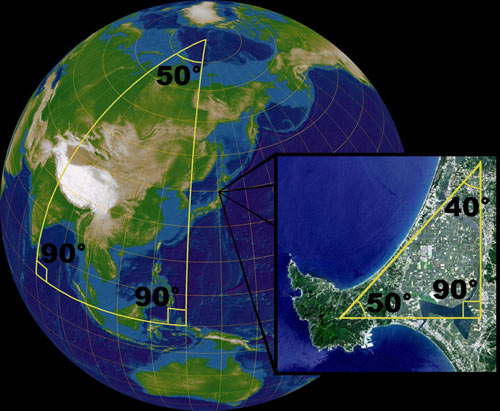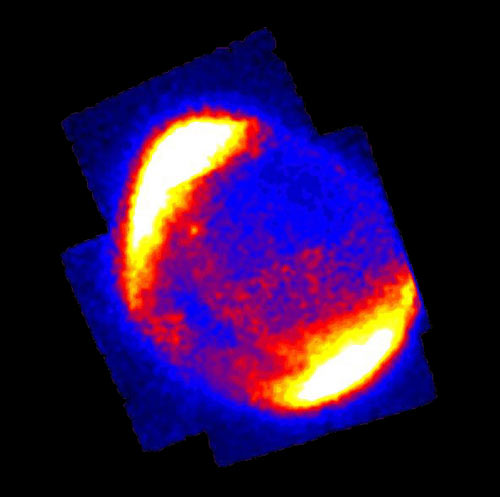Big Triangles
A few years back, people believed the world to be flat. It is now generally accepted that the world is spherical. One has to be appreciably far from the earth to observe its spherical form. The fact that it is a sphere allows airplanes and communication satellites to circumnavigate around it and connect our world. Otherwise, we all keep pretending it’s flat anyway and don’t think much about it.
Similarly, our universe has three possible shapes: flat, positive curvature and negative curvature. The jury is out as to which form it has. To understand the implications of curved, or non-Euclidean space, let’s imagine a triangle overlaid on top of the globe.

From this picture, we can see that the triangle intersects the equator at right angles. Our curved space triangle now contains more than 180 degrees within its angles, not possible in Euclidean geometry.
If our universe is curved, an object traveling in a straight line may not be going straight at all. A jet flying north may seem to be flying straight on to its passengers, but in reality it is following a curved path around the globe.
If we were to aim a beam of light towards a Alpha Centuari (towards where it would be four years from now of course), it would most likely arrive in tact due to the incredibly boring and empty stretch of four light years that separate us. Like our airplane, would the light have traveled in a straight path to get there?
Light sent from Earth to Alpha Centauri
Double click to play:
[qt:/blog/movies/curve1.mov /blog/movies/curve1_poster.mov 400 270]
I had an idea about measuring the shape of the universe. Using some basic geometry, spectroscopy and simple measurements, we might be able to look deeper into this.
Modern telescopes allow supernova events to be recorded with great detail. If one of these explosions can be observed inside a symmetrical nebula, the light energy escaping from it could tracked over a series of years.
Double click to play:
(I got this movie from here.)
[qt:/blog/movies/sn2006gy_anim_lg.mov /blog/movies/sn2006gy_anim_lg_poster.mov 480 320]
The luminous border of the nebula, depending on its composition and density, would expand at or nearly the speed of light. This has been shown in Supernova 1006, which took place about a thousand years ago.

The lateral growth of the nebula represents the base of our interstellar right triangle. With a little geometry, we might be able to figure out how our universe is curved (at least between us and the supernova).
Light emitted from a Supernova heads to Earth
Double click to play:
[qt:/blog/movies/supernova.mov /blog/movies/supernova_poster.mov 400 270]
Why does it matter?
The shape our universe is what will determine its fate. Without going into details, if you have any interest in the future, higher powers, fate and such, this is it.
Concerns:
The gas particles in the nebula will slow the light down. Absorption spectra could be used to determine the composition and (possibly?) the density of the nebula.
Space may not be curved enough to be observable at the given distance.
Does light play by the rules? We know it is affected by gravity but how would it interact with curved space?
This is not meant to be a scientific exploration. It’s just a thought I had while daydreaming in class.
We should make some big triangles to figure out how it will all end…